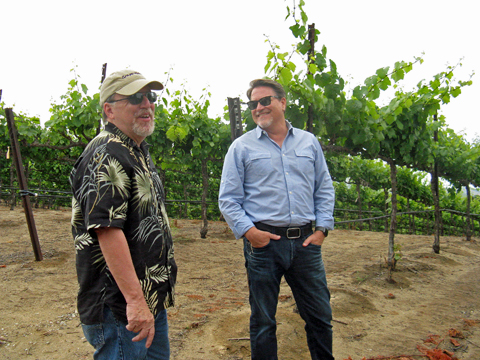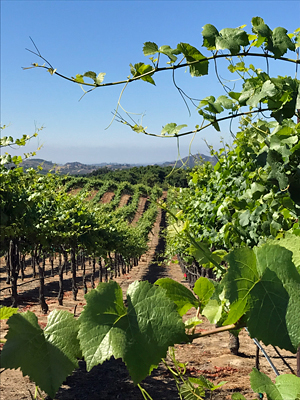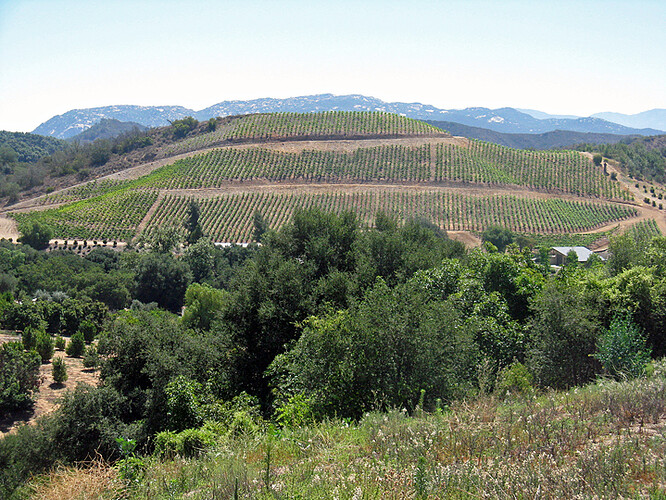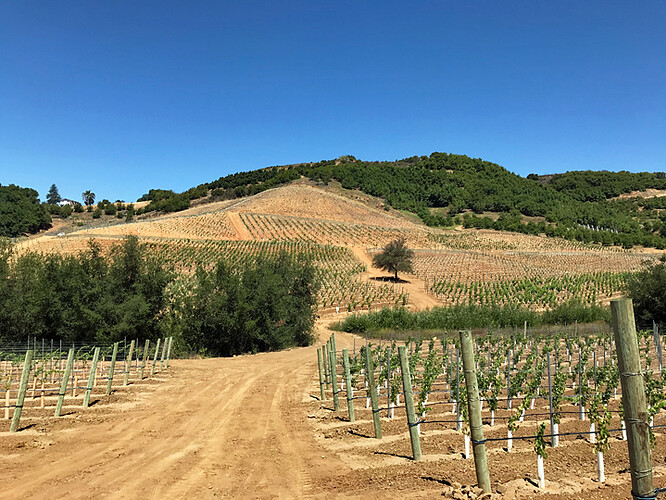Southern California Wine Tour – June 2018, Part 4A – Temecula
I’ve posted a portion of a report on a late-June wine trip to Southern California wine country – San Diego County, Temecula Valley, and Cucamonga Valley. The report has been split into four parts, and the portion below is from Part 4 of 4. I split Part 4 into two segments for posting here since each segment is from a very different wine region in Southern California. I’ll post the final segment shortly. The full reports for each day of the trip can be found on the Grape-Nutz.com website – here’s the link for Part 4:
Southern California Wine Tour – June 2018 – Part 4
Sol De Luz / Sweet Oaks
Eric, Jay, Paul, Barry, and I had visited wineries in San Diego County and Temecula Valley on the first three days of our Southern California wine tour. Despite their proximity, the two regions are very different in many ways, but we found good wines in both of them. Tuesday was the final day of our tour, and it would include a visit to one of Southern California wine country’s newest producers as well as one of its oldest.
Sol De Luz / Sweet Oaks
When I had been researching possible places to visit in the Temecula area prior to our wine tour, I came across a couple of web articles about a new wine project called Sol De Luz. The information looked intriguing right away – planting in the cooler and wetter hills above Temecula Valley. And when I saw that the winemaker for the project is Mark Horvath – with whom both Eric and I have tasted on a few occasions, most recently for his own Crawford Family Wines label – I knew I had to visit and find out more. Mark arranged for us to meet him just off the intersection of two roads climbing into the rugged hills west of Temecula, and we had no trouble finding him there. Mark greeted us, and also introduced us to Aaron Saltzman, the marketing director for Sol De Luz and sister label Sweet Oaks – both led us on a tour of three of their vineyards in the hills that morning.

Sol De Luz and Sweet Oaks are run by Heather Petersen and Jason Altpeter, who were recently married. Originally from Ohio, Heather founded the National Merchants Association, a credit-card processing firm, in 2004. In 2014, she began buying property in the De Luz area, a mountainous region west of Temecula Valley that extends to the eastern edge of the Marine Corps’ coastside Camp Pendleton. Heather has continued to purchase property in this area, as well as some in Temecula Valley as well. Farming is in her family’s background, and she saw the potential for the De Luz region to grow high-quality winegrapes and to share in the wine / events business that has been so successful in Temecula.
Heather met Mark in 2016 through a mutual friend, and brought him into the project as the winemaker. Mark grew up in Mission Viejo in Orange County and worked in hotel management before he refocused his career toward wine. He started out in wine working in Sonoma County but he’s best-known for his work in Santa Barbara County. He joined Babcock Winery in 1998 and became their winemaker, and along the way he formed the Kenneth-Crawford label with friend Kenneth “Joey” Gummere in 2000. Mark established the Crawford Family Wines label with his wife Wendy in 2011 (Crawford is the maiden name of Mark’s mother as well as his middle name). Mark is continuing to make the Crawford Family wines in Buellton in addition to his new role in Sol De Luz and Sweet Oaks.
Mark told us that he liked the idea of the Sol De Luz project in part because it would be starting from scratch, but he admitted he was unsure about the Temecula region at first. He said that there are a number of talented winemakers there and that overall quality is on the way up, but he feels the farming of many of the area’s vineyards is still not as good as it could be (something that can be said of a number of other California wine regions as well). Mark feels there is a market for different and more elegant wines than most of those that are typically produced in the Temecula region, and the Sol De Luz wines could help fill this niche.
The higher-elevation De Luz region is cooler than Temecula Valley (though it’s still certainly not “cool climate”) and it gets more ocean influence and more rain. Morning fog is common, as we saw at the first vineyard site that Mark brought us to during our visit. Soil in the area tends to be volcanic and clay, as opposed to the decomposed granite that is ubiquitous in Temecula Valley. The De Luz region already has a number of smaller “mom and pop” vineyards scattered about the hills, and their fruit goes to various Temecula producers, but De Luz is little-known outside the local area. In an effort to help create more of an identity for De Luz, there is an effort underway to have a new AVA created for the area. Wes Hagen, who has worked on other AVA petitions (most notably for Sta. Rita Hills) is heading up the work on this. The proposed boundaries of the AVA have not yet been finalized but Mark said that the new appellation is expected to be mostly, and perhaps entirely, within the existing Temecula Valley AVA. The exact name for the proposed AVA has not been finalized either – I’ve seen references to De Luz Hills and De Luz Highlands as possibilities. The hope is to start the formal AVA review and approval process sometime this year – the entire process often takes several years.

Jay Selman and Mark Horvath at Serreno Vineyard
Currently, six vineyard sites with a total of 87 acres have been planted or are in the process of being developed for Sol De Luz and Sweet Oaks, with most of the new planting in the De Luz area. Scott McIntyre of Sierra Pacific Farms is the vineyard manager, and Jim Stollberg of Maverick Farming Company is the consulting viticulturist. All of the new vineyard sites will be farmed sustainably with an aim of being SIP (Sustainability in Practice) certified – nearly 200 California vineyards are currently certified under this program.
Mark told us that over 20 grape varieties are currently planted, including some pre-existing plantings. He noted that the Sweet Oaks site in Temecula Valley has Pinot Gris and Muscat that had not been tended for some time and they’re working to bring back those vines. Mark mentioned that Heather loves Sangiovese and Cabernet Franc in particular, so those varieties are among the new ones being planted. It is expected that it will take some time to find out what does well at the different sites. Mark feels that Grenache will thrive in the area, and they are planting a lot of this variety both for red and rosé production. There are interesting twists to some of the new plantings, such as one block where Syrah, Grenache, Mourvèdre, Cinsault, Counoise have been interplanted. New plantings are typically on 6x3 spacing, while older existing ones have the wider vine spacing typical of Temecula. The plan is to keep most or all of the estate fruit for the two new wine labels.
Sol De Luz and Sweet Oaks are related labels but the intention is to keep their focus separate. There has not yet been any wine produced under the Sol De Luz label, while Sweet Oaks bottled wine for its first vintage not long ago. These first Sweet Oaks bottlings include Chardonnay, Viognier, Zinfandel, Malbec, and a Grenache-Syrah blend. The wines are currently produced at Sweet Oaks Ranch in Temecula Valley, another property that Heather purchased, and there is a new wine facility in the valley being built for production of both labels. The Sol De Luz wines, which are expected to debut in 2019, will be considered the project’s top-tier bottlings. Mark mentioned that growing a lot of varieties will allow them to make quite a few different wines, which is good for direct-to-consumer sales. Some varieties are being planted specifically for wine club offerings – the idea is to develop a few particular small-production wines as club-only bottlings. Expected production for this year’s vintage is expected to be around 6,500 cases, then ramping up to about 12,000 next year, and ultimately aiming for 42,000 cases in 2020 when most of the new vineyards come online. A tasting room is being planned for Old Town Temecula.
There’s obviously a lot for Mark to do with all of this work on the new project going on, and he told us that he’s been spending four days a week in De Luz, flying down from Santa Barbara County. This year will be the first big harvest for the new project, and Mark is hoping that the timing will work out between Sol De Luz and Crawford Family. He thinks that harvest in De Luz will be winding down about the time that it will be starting up in cooler Santa Barbara County, but he’ll still need to find out how it works out. Mark mentioned that it will take some time to find out how the fruit develops at the new vineyard sites, and he noted that he will be dealing with less “hang time” for the fruit there than what he’s used to in the cooler Sta. Rita Hills region. To help things go smoothly during harvest and crush, Mark has hired an assistant winemaker for Crawford Family Wines (the first time he’s done that) and there is also one at Sol De Luz, so thinks that things will be covered all around.

Serreno Vineyard
After our group chatted with Mark and Aaron for a few minutes, they led us along hilly roads to three vineyards, each in different stages of development. Our first stop was Serreno Vineyard – all of the vineyards are currently named for the roads on which they’re located, though Mark mentioned they may give them different names at some point. Serreno is an existing vineyard that Heather purchased in 2016, and 2017 was Mark’s first year working with it. Situated on a sloping hillside with mostly sand and clay soil, the vineyard was planted about 15 years ago to Chardonnay and Pinot Noir, plus a little Merlot and Syrah. Chardonnay and Pinot Noir in Temecula? On the morning we visited this was indeed a foggy and cool spot, farther to the west than the other sites we visited a short time later, though Mark pointed out that it’s still not nearly as cool as the Sta. Rita Hills sites he works with for his own label. The views from Serreno Vineyard made it a perfect spot for Mark to show us how distinct the De Luz area is from the rest of Temecula, sort of a buffer zone between coastal Camp Pendleton and hotter Temecula Valley. Eric summed up the key moment as we listened to Mark at the vineyard:
Mark killed it for me with “this is the desert” (gesturing toward Temecula), (pause) “and this is not” (gesturing toward the coast). Nothing could have been clearer.
Our next stop was at Calle Cresta Vineyard, on a dramatic steep hillside. This had formerly been planted with citrus trees but was abandoned, and the trees mostly dead, before it was planted with grapevines. During our drive through the De Luz region, we saw other hillsides with dead or dying citrus and avocado trees. These had been widely-planted in the area, but they are water-intensive crops, and there are currently financial incentives of up to $15,000 per acre from the local water district to convert farming from citrus and avocado to less water-intensive winegrapes. Mark noted that well water quality in the area is poor and water is actually piped in from the city of Temecula.
Calle Cresta Vineyard
Calle Cresta is the first of the new De Luz vineyards that has been developed. The 9.7-acre vineyard is on a dramatic steep hillside at a warmer but windier spot than Serreno Vineyard, with volcanic and sedimentary soil. Most of it is on a south and southwest-facing slope, with smaller portions southeast-facing and a little more north-facing. It’s planted mainly to Sauvignon Blanc, which is trellised, while the upper parts of the slope are head-trained Sangiovese and Cabernet Franc. We’d noticed that we had not passed through any deer fencing at the two vineyards we’d visited, and Mark told us that, surprisingly, there are no deer in the area. He said they are waiting to see whether they will need bird netting at Calle Cresta, and mentioned that they have needed to put up bee netting at Serreno Vineyard. Heather is planning an wedding / event venue at Calle Cresta, and possibly a future tasting room. I asked Mark how neighbors feel about the potential for such development in the area and he said that while some neighbors are concerned, most seem supportive.
Our third and final vineyard visit with Mark was at Calle Jardin Vineyard. Spread out along gently-sloping hills, with a small creek running through the site, it had been an abandoned avocado orchard with dead trees prior to the new vineyard development. The soil there includes volcanic, clay, decomposed granite, and sand. The site is large enough that it is being planted in two stages – most of it was planted last year (Mark called that portion “Jardin 1”) and the rest still being developed and will be planted this fall (“Jardin 2”). Jardin 1 includes Sangiovese, Cabernet Franc, Cinsault, Petite Sirah, and Albariño, while Jardin 2 will include Zinfandel, Cabernet Sauvignon, Barbera, Nebbiolo, Arneis, Sangiovese, Pinot Gris, and Mourvèdre. The Albariño is planted in sandier spots near the creek, and Mark pointed out Petite Sirah on the upper part of the hill beyond. The Sangiovese vines are head-trained, as well as some of the Cab Franc. Mark noted that development of the Cabernet Franc, Cinsault, and Albariño vines is coming along faster than the other varieties at Calle Jardin. Although some of the site is in sort of a lower-lying bowl in the landscape, Mark said there should be no frost issue for the vines, as frost season is typically over by late February there. Heather is planning a tasting room and hospitality center at the site as well as a winery and a chilled storage area, to hold fruit before it is processed there or at Sweet Oaks. Mark said that other vineyard sites in the De Luz area are currently being developed, but the current focus is on Calle Cresta and Calle Jardin.
Calle Jardin Vineyard
Wow, this was a fantastic tour of the new Sol De Luz project with Mark and Aaron! It was fascinating to see the various vineyard sites and how they differ from one another as well as how different they are to vineyards in Temecula Valley itself. The creation of a new AVA for the area will help to further differentiate it from the rest of the Temecula area. It was great to see so many varieties going into these new vineyard sites with the goal of seeing what will work well at each location, and with the idea of fine-tuning the plantings once Mark and the Sol De Luz team learns what’s working and what’s not. I’m looking forward to trying the Sol De Luz wines when they’re released. This looks like an exciting new project, and it should be fun to watch how it develops in the years to come.

Looking up at steep Calle Cresta Vineyard

